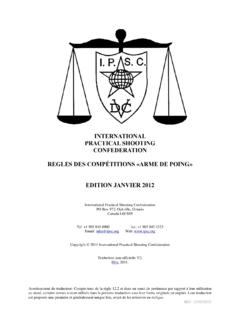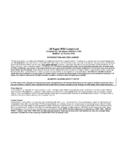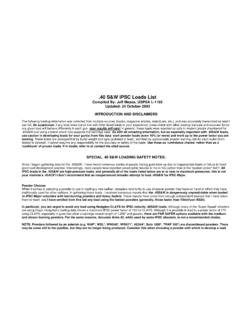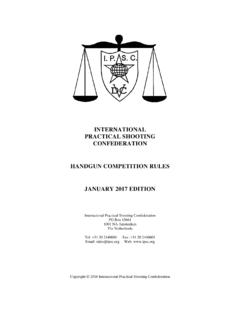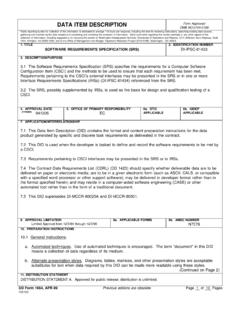Transcription of Introduction to IPSC/ Practical Shooting - NGPSA
1 IPSC Introduction for Beginners Page 1 Introduction to IPSC/ Practical Shooting IPSC Introduction for Beginners Page 2 Table of Contents Introduction to IPSC/ Practical Shooting .. 1 1. What's Practical Shooting ? .. 4 Overview .. 4 The principles of the sport .. 4 Background .. 5 The Equipment Race .. 6 2. Start Practical Shooting Safely .. 6 The Four Laws of Gun Control .. 6 THE 1st LAW - THE GUN IS ALWAYS LOADED! .. 7 THE 2nd LAW - NEVER POINT THE GUN AT SOMETHING YOU ARE NOT PREPARED TO DESTROY! 7 THE 3rd LAW - ALWAYS BE SURE OF YOUR TARGET AND WHAT IS BEHIND IT! .. 7 THE 4th LAW - KEEP YOUR FINGER OFF THE TRIGGER UNTIL YOUR SIGHTS ARE ON THE TARGET!
2 7 GUN CONTROL = SELF CONTROL .. 7 Equipment .. 7 Basic Skills .. 9 10 Safe Dry Fire Practice At Home .. 10 The Draw and Fire Sequence .. 11 Reloading, Movement, and other Skills .. 12 Practicing .. 13 3. The Rules of the Game .. 14 Safety and Disqualification .. 14 The Safe Area .. 14 Range Commands .. 15 , Open, Standard, Production and Revolver.. 16 Power Factor, Targets & Scoring .. 17 Power Factor .. 17 20 Scoring Method .. 23 Your First Match .. 23 IPSC Introduction for Beginners Page 3 Registration .. 24 On the Firing Line .. 25 4. Where to find more information .. 27 Other Internet IPSC resources.
3 27 Books, videos .. 27 Related Shooting sports .. 27 3-gun competition .. 28 Action Shooting /Bianchi Cup .. 28 The Steel Challenge .. 28 5. Training Tips .. 29 Identifying What's Wrong .. 29 Attitude .. 30 Gun Problems .. 30 Erratic Performance .. 31 Burnout .. 32 Final Thoughts .. 33 6. PISTOL DRY FIRE/LIVE FIRE .. 33 Things to remember .. 33 Practice Drills .. 34 Live Fire Practise 35 7. Reference Material .. 35 IPSC Introduction for Beginners Page 4 1. What's Practical Shooting ? Overview You may have seen it on television, in a gun magazine, or at a local range. A shooter runs and guns through an obstacle course of realistic props.
4 Paper targets and steel plates are engaged, rapid-fire, as moving targets are activated and drop in and out of sight. Blazing man-on-man shoot offs where hundredths of seconds decide the winner. Incredible feats of Shooting skill performed at warp speed. What you saw was Practical Shooting competition, perhaps at the USPSA Nationals, Steel Challenge, Bianchi Cup, or one of the thousands of other matches shot each year by clubs all over the world. Practical Shooting is a sport in which competitors are required to combine accuracy, speed and power to successfully complete many different types of Shooting 'problems'.
5 Competitors use centre fire handguns in large calibres (9mm/.38 special is the minimum allowed) and shoot full-power loads. Fewer points are awarded to competitors using 'minor' power loads. These handguns are carried in belt holsters and are accompanied by spare magazines or speed loaders in pouches also attached to the belt. At any given match a shooter may be required to shoot targets 2 meters away in one event, and 50 meters away in the next. Sometimes the targets are paper, sometimes they are steel. Often 'no-shoot' penalty targets are placed near 'shoot' targets. Points are subtracted from a shooter's score for hitting the 'no-shoots'.
6 Realistic props are used to simulate a scenario that the shooter must complete. Shooting may be done from freestyle, strong hand, weak hand, prone, or any other imaginable position, depending on the course of fire. Since scoring uses both total points and elapsed time, the shooters strive to find the best combination of accuracy, speed, and power to win. Practical Shooting is what you want to make of it. You can gear up and become a Serious Competitor. The choice is yours. The sport recognizes many different aspects of individual excellence. There is a wide diversity of attitudes among the shooters at a match.
7 For some, the match is part monthly practice, part social occasion. They enjoy the challenge, the fun and social aspects of the sport, and don't take things too seriously. At the other end are the athletes - the Serious Competitors. They respond to the challenge by employing modern sports training techniques to condition mind and body to peak performance. In between are all sorts of shooters. The principles of the sport The following principles are established to define the nature of Practical Shooting . They are accepted by all members of the International Practical Shooting Confederation (IPSC) as conditions of membership.
8 1. Practical competition is open to all reputable persons without regard to occupation; it may specifically not be limited to public servants. 2. Accuracy, power and speed are the equivalent elements of Practical Shooting and Practical competition must be conducted in such a way as to evaluate these elements equally. IPSC Introduction for Beginners Page 5 3. Firearm types are not separated, all compete together without handicap. This does not apply to the power of the firearms, as power is an element to be recognized and rewarded. 4. Practical competition is a test of expertise in the use of Practical firearms and equipment.
9 Any item of equipment, or modification to equipment, which sacrifices Practical functionality for a competitive advantage contravenes the principles of the sport. 5. Practical competition is conducted using Practical targets, which reflect the general size and shape of such objects as the firearms may reasonably be called upon to hit in their primary intended use. 6. The challenge presented in Practical competition must be realistic. Courses of fire must follow a Practical rationale and simulate sensible hypothetical situations in which firearms might reasonably be used. 7. Practical competition is diverse.
10 Within the limits of realism, problems are constantly changed, never permitting unrealistic specialization of either technique or equipment. Courses of fire may be repeated, but no course may be repeated enough to allow its use as a definitive measure of Practical Shooting skill. 8. Practical competition is freestyle. In essence, the competitive problem is posed in general and the participant is permitted the freedom to solve it in the manner he or she considers best within the limitations of the competitive situation as provided. Background 'Action Shooting - Practical Shooting - IPSC - USPSA'. These terms and acronyms have been seen a lot in recent years.


